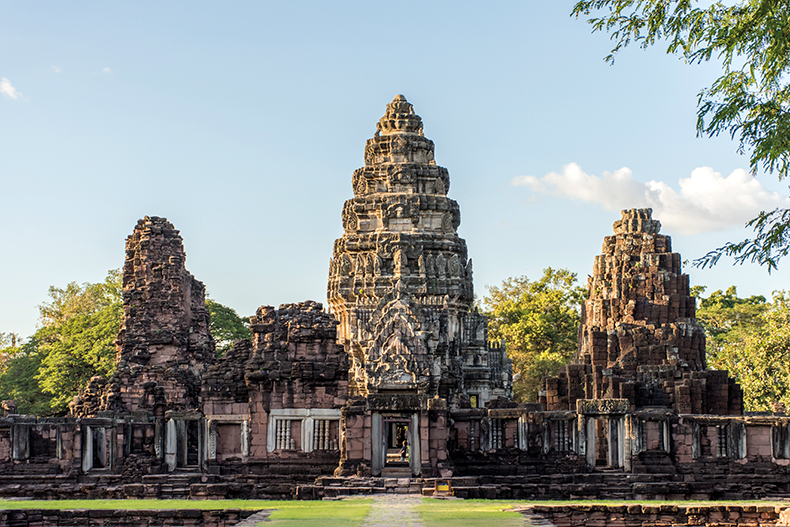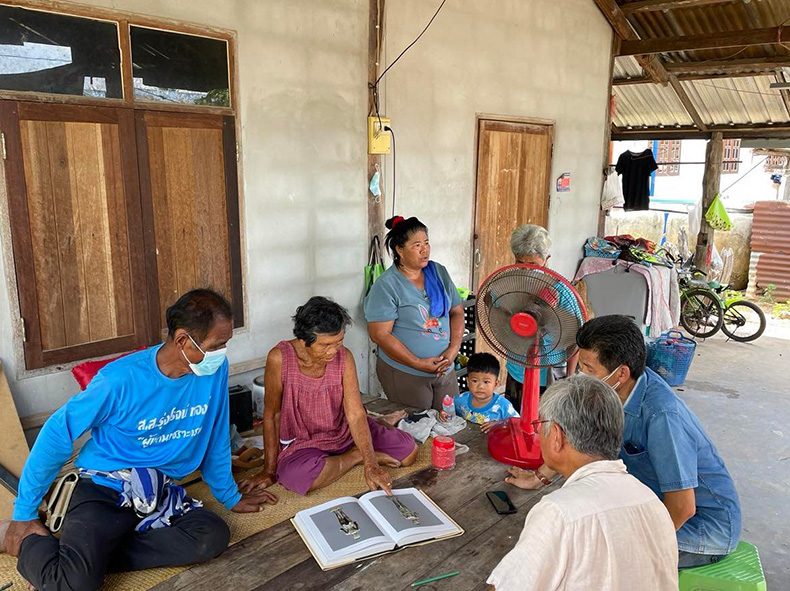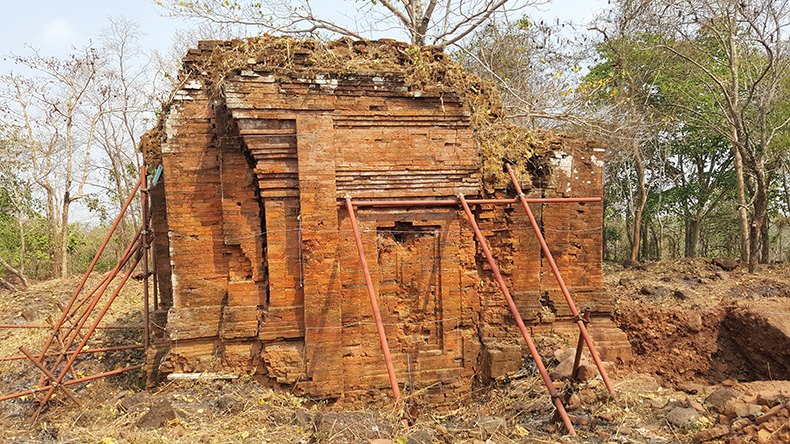From the May 2024 issue of Apollo. Preview and subscribe here.
When, last December, the Metropolitan Museum of Art announced its plan to deaccession 16 Angkorian sculptures, Cambodians and Cambodia watchers were overjoyed, although not altogether surprised. In its press release, the Met said that the pieces were ‘known by the Museum to be associated with the dealer Douglas Latchford’. Some form of action had been anticipated for some time and certainly since August 2022 when the New York Times had published a report outlining the country’s claims to more than a dozen artefacts in Gallery 249, and citing as compelling evidence the recollections of looters and emails handed over by Latchford’s daughter after the death of the disgraced art dealer in 2020.
There was, however, one startling aspect of the Met’s announcement: a gilded-bronze statue listed on its website as a ‘Standing Shiva (?)’, once described as Cambodian until recently, would be going to Thailand instead. Andy Brouwer, a Phnom Penh-based British researcher of Cambodian history, wrote on his Facebook page, ‘The Thais have clearly prevailed in their attempts to convince the Met that the bronze sculpture should be returned to them, ahead of any claim Cambodia may have had.’ Within hours, more than a hundred people had commented, revealing a deep-seated ethnonational rivalry. ‘l don’t know why it is being sent to Thailand, not to the motherland (Cambodia),’ huffed one person, echoing a common sentiment: that the statue known as Golden Boy is an ancestor of the Khmer people and, as such, belongs on Cambodian soil.
Meanwhile, the Thai government, which, in June 2017 set up a committee for the repatriation of stolen artefacts but has yet to emulate the successes of Cambodia’s more media-savvy restitution team, issued a glowing statement. ‘We are very pleased that The Met has reached out to us,’ said Phnombootra Chandrajoti, director-general of Thailand’s Fine Arts Department. ‘We view this return as a significant milestone in our ongoing efforts to repatriate cultural treasures.’
The Khmer gilt-bronze statue known as Golden Boy dates from the 11th century. It was in the collection of the Metropolitan Museum of Art from 1988–2023 and is being returned to Thailand. Photo: courtesy Metropolitan Museum of Art

These different reactions to the fate of Golden Boy – once described by the Met as ‘certainly the most important gift of a Southeast Asian sculpture ever made to our collection’ – are a reminder of how the Hindu-Buddhist Khmer Empire extended in territory and influence, between the 9th and 15th centuries, across what is now the Cambodia-Thailand border. They also point to how that empire’s legacy is regarded in Thailand today.
Historians have identified intangible traces of Khmer influence in the kingdoms that are considered the cradles of the Thai nation-state, including the royal court of Ayutthaya. But Thailand has also claimed ownership of tangible Khmer heritage, particularly during the 19th century when Siam (as the kingdom was then known) controlled the province containing the capital, Angkor. King Mongkut (r. 1851–68) even demanded that a replica of the site’s most imposing religious edifice, Angkor Wat, be constructed on the grounds of the royal palace in Bangkok.
These claims would recede in the 20th century. In 1907, Siam was forced to relinquish the province containing Angkor to the French protectorate of Cambodia. In 1962, Thailand lost its case against Cambodia about its claim to the temple of Preah Vihear in the disputed border region, at the International Court of Justice. The anthropologist Charles F. Keyes wrote that Thailand’s legal defeat over Preah Vihear ‘stimulated the Thai government to make a place for the Angkorean legacy in the Thai national heritage’. Over the next quarter of a century, it restored Phimai and Phanom Rung, the two major sites from the Angkorean period still under Thai control and, during Cambodia’s civil war (1967–75), began promoting these sites in the north-east of the country as alternatives to Angkor.
There was another spike of Thai interest in Khmer history in early 1988, when a long-running campaign calling on the Art Institute of Chicago to return a stone lintel carved with an image of the Hindu god Vishnu – and looted from Phanom Rung in the early 1960s – became a national cause célèbre. Spurred by the reopening of the newly reconstructed site, the movement staged protests outside the museum and even spawned a hit song by rock group Carabao that called on the United States to ‘take back Michael Jackson!’ in return for the Phra Narai lintel.
Much more recently, two Khmer lintels removed from the Asian Art Museum in San Francisco by a US Homeland Security Investigations team received a well-publicised ‘homecoming’ in May 2021 and were subsequently exhibited at the National Museum Bangkok. However, the impending return of Golden Boy (originally due to take place in May but delayed because of logistical issues) has already dwarfed them in terms of domestic media attention and academic excitement.
Efforts to deduce who the figure depicts (it ‘defies ready identification,’ says the Met’s online listing) and to understand its religio-political significance, are already well underway in Thailand. This can be seen in the February 2024 issue of Silpawattanatham magazine and an accompanying four-part podcast series hosted by leading Thai archaeologists and art historians. Much of the expert opinion agrees with that of Martin Lerner, the former curator at the Met who suggested, in the museum’s Fall 1989 acquisitions bulletin, that the figure likely depicts a devaraja, or deified monarch, perhaps the Khmer king Jayavarman VI, ‘whose accession took place in 1080’.
The ruins of the Khmer temple, built by Jayavarman VI at Phimai in north-east Thailand. Photo: Chansak Joe/Getty Images

Thai experts are also presenting theories that expand on, or diverge, from earlier readings. Pointing to the features of Golden Boy – the finely worked patterns of his ornate belt and braided hair, for example – an archaeologist on Thailand’s repatriation committee, Tanongsak Hanwong, posits that he should maybe be understood as an example of Phimai style rather than the earlier Baphuon style that emerged under Udayadityavarman II (r. 1050–66), who built Baphuon temple at Angkor. He believes that under Jayavarman VI, who is widely thought to have built Phimai in the late 11th century, there was a flourishing of a style that represents a transitional link in Khmer art. Golden Boy’s presence is also used to support a claim that this region was once home to a pre-Angkorean kingdom, Mahidharapura, that had Jayavarman VI as its head and Phimai at its ceremonial centre.
In 2012, the anthropologist Alexandra Denes argued that, from the 1960s onwards, Khmer heritage within the Thai nation-state became ‘a metonymic substitute for the “loss” of Angkor as a site of cultural origins’. But these vigorous early attempts to interpret Golden Boy through a local lens also suggest that it is not merely a proxy for nationalistic sentiment, but a piece of material culture that possesses its own iconographic secrets.
Moreover, these efforts reflect a widely-felt desire to make up for lost time. ‘Had it been properly excavated, then we would have had scholarship on it 40 years ago,’ says Angela Chiu, a London-based expert on Thai Buddhist art. ‘I think it’s amazing how, since the statue came into the news, all these Thai experts on the history of north-east Thailand are now engaging with it. You can already see the difference it has made.’
However, thorny questions surrounding Golden Boy’s provenance have not yet been officially addressed or resolved. At time of writing in mid April, the Met has not disclosed how it came to its decision, or how it established an association between Latchford and the 16 objects it has deaccessioned. Nor has the Thai repatriation committee explained why the Met ‘proactively’ proposed the return of two objects not on the country’s official list of items it wants returned from US museums. (The Met is also sending back a ‘kneeling female figure’ from the late 11th century.)
In 2019, the U.S. Attorney’s Office for the Southern District of New York charged Douglas Latchford, a recognised expert in Khmer antiquities, with trafficking in looted Cambodian objects and falsifying documents. The art dealer died before the indictment went any further. In 2021, Latchford’s daughter donated 125 objects from his Khmer collection to the Cambodian government and, two years later, forfeited $12m from her father’s estate to settle a civil case.
While attention to date has mostly centred on Latchford and Cambodia, independent research made public by Chiu and Hanwong also points to a Latchford connection in north-east Thailand – and Golden Boy is at the heart of it. The question of where Golden Boy and pieces of a similar style came from has been at issue for some time. As Chiu points out, in the 1988 book Thai and Cambodian Sculpture from the 6th to the 14th centuries, Lerner listed the provenance of a ‘large gilded deified standing king’ as ‘Thailand, Buriram Province’. But in the Met’s 1989 bulletin announcing its accession he described it as ‘Cambodian’.
Chiu’s own suspicions about Latchford’s involvement were prompted by the fact that Golden Boy came as a ‘partial gift’ from the collection of American media baron Walter Annenberg, who bought a ‘half-interest’ from Latchford’s go-to London dealer, Spink & Son. Latchford and his academic collaborator, the late Emma C. Bunker, also co-wrote three books on Khmer artefacts in which they claim that several ‘Baphuon-style’ pieces, including the ‘famous Baphuon-period gilded male figure in The Metropolitan Museum’, were wrongly identified as Cambodian.
Testimonials gathered on the ground in Thailand also resonate strongly with Latchford’s own descriptions of his collecting in the 1960s and ’70s: a period when, as he said in a 2008 interview with Apollo, he spent time exploring Thailand’s temple-city ruins and hunting down off-site sculptures: ‘I would show local governors a picture of a sculpture and ask them if they’d seen anything like it,’ he recalled.
A villager in Ban Yang village, Buriram province identifies Golden Boy in one of the books on Khmer artifacts produced by Douglas Latchford. Photo: © Lalita Hanwong

During the pandemic, Chiu came across a footnote in Latchford and Bunker’s book Khmer Gold (2008) that claims that Golden Boy was ‘actually found at the village of Ban Yang, Lahan District, where its stone base is still visible, and not in Cambodia’. In a documentary broadcast in October 2022 by CNA, a Singaporean news channel, Hanwong – who lives in the north-east – follows this clue to a Ban Yang village in Buriram. Here he finds a stone plinth that is not only visible, but also appears to match the proportions of the bronze block on which Golden Boy stands. He also meets a former village headman who recalls the piece’s discovery in 1975 and sale for one million baht (USD 27,000) being the ‘talk of the town’, and that Latchford stayed at his house. An 83-year-old woman recounts, in a local Khmer dialect, her late brother discovering the piece lying in the soil while ‘digging potatoes’.
The film captures Hanwong’s elation upon making these discoveries. ‘What are the chances that we will get the statue back from the Met? Have our chances increased?’ asks his wife, Lalita Hanwong. ‘Yes, almost 100 per cent,’ he replies. ‘Everything on tape can be used as evidence in the legal battle.’
Today, there is also excitement in Ban Yang, where villagers recently staged a redemption ceremony for having wronged King Jayavarman VI’s spirit almost 50 years ago. Many of them want to see the god-king’s physical return being used to develop their community and turn it into a tourist attraction, although stumbling blocks remain. Integral to the success of such a plan, Hanwong believes, would be the as-yet-unresolved repatriation of some other bronzes thought to have been acquired by Latchford in Buriram province in the mid 1960s: a cache of pre-Angkorian sculptures of sundry sizes known as the Prakhon Chai hoard. Unlike Golden Boy, many of the finest examples – some of which can be seen in US museums – are on Thailand’s repatriation list.
‘I’ve been trying to explain to the villagers that it’s very important to have a small place where these pieces could be displayed,’ Hanwong says, ‘but also that it’s even more important to have a story or local narrative that connects all these pieces together, not just Golden Boy.’ That story, he believes, is the advent of Mahayana Buddhism across the Khorat plateau in north-east Thailand, an area dotted with the ruins of Khmer sanctuaries, rest houses, hospitals and roads. While Prakhon Chai sculptures – which typically depict earthly or future versions of Buddha, or bodhisattvas, clad in sampots (loincloths) – predate Jayavarman VI, Hanwong suggests that they were still respected and worshipped during his reign. ‘King Jayavarman VI practised Mahayana Buddhism,’ he says. ‘We know this because when he ascended the throne, he built Phimai, the largest Buddhist castle in the region.’
The ‘Prakhon Chai hoard’ of bronzes was dug up in the 1960s at the site of the 10th-century Plai Bat II temple in Buriram province, north-east Thailand. Photo: © Lalita Hanwong

But telling this story, or a version of it, on the ground through museological displays, may prove tricky. According to Phacha Phanomvan, a heritage scholar and archaeologist, Thai government regulations state that ‘community museums cannot hold real antiquities’. On past occasions, this has led to awkward situations where a community wants a repatriated object back and installed on the site, but officials can provide only replicas.
All that is certain, for now, is that the remarkable gilded-bronze sculpture known as Golden Boy will go on temporary display at the National Museum Bangkok – and become an official part of Thai heritage. Meanwhile, Cambodia’s investigation into what its restitution team still calls a ‘Baphuon-style’ piece continues. ‘We haven’t completed our research on Golden Boy yet; we’re still evaluating the history behind it,’ says Bradley J. Gordon, an American lawyer leading the team. ‘We were surprised the Met chose this particular timing for the return.’
With the history of many Khmer bronzes obscured, or irretrievably lost, some observers worry that the lack of concrete evidence in such cases – revelations in discredited books and witness statements are hardly watertight – is being exploited: used to pit the two countries against each other and stall repatriations.
‘The fact that materials were made and circulated throughout an empire that now straddles Cambodian and Thai national borders made for a trafficking paradise during the decades of war and instability,’ explains Ashley Thompson, a professor of art and archaeology at the School of Oriental and African Studies in London, ‘but also provides a convenient ambiguity to museums, collectors and dealers with an investment in retaining stolen goods.’ She would like to see a more cooperative approach between the two countries and that they ‘even engage in shared custodianship of materials whose exact provenance on this or that side of a modern-day border cannot be determined’. Given the nationalistic sentiment swirling around discussions of Khmer heritage, however, not to mention the rapturous ‘homecoming’ that awaits Golden Boy, such pragmatism currently seems far-fetched.
From the May 2024 issue of Apollo. Preview and subscribe here.
17.05.24: Correction – it was the U.S. Attorney’s Office for the Southern District of New York that indicted Douglas Latchford in 2019 and not the Manhattan District Attorney’s Office.


